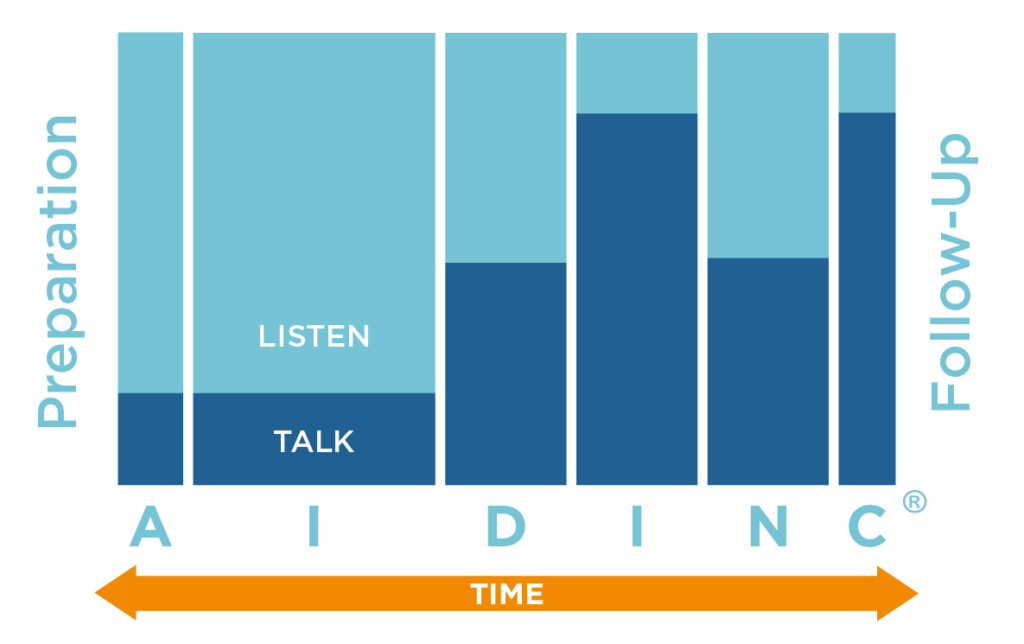What Football Teaches Us About A Strong Sales Framework

As a high school football coach, I always get excited this time of year. A new team with a fresh group of kids — kids who unabashedly love the game, have a passion for getting better and strive to compete. Kids who represent their communities, fellow classmates and their families. And they’re all going after a common goal: a championship.
Bringing a new group of players together also brings with it unique new challenges — kids who’ve never played before, kids coming back from injury, kids who grew over the summer and are no longer good fits for their current position or may have lost their passion for the game. It always amazes me how each team takes on the personality of their leaders, whether they’re hard-working, blue-collar kids that strap on their helmets humbly or the exact opposite. As coaches, it’s up to us to put each player in the best position to succeed, teaching the mindset, skillset and disciplined processes needed to win the next play.
While addressing mindset in football is a whole other conversation (and post), what dawned on me recently is how great the game is at illustrating the sales framework we at Integrity Solutions call AID,INC.
To show you what I mean — and to see how you can apply this sales framework to your own selling — let’s explore this sales approach a bit further. Ready? Down… Set… Go!
Pregame (Preparation)
The pregame phase of football includes film study and the development of a clear and focused game plan. The more tape you watch, the more insights you obtain — things like tendencies of play calling, tell-tell signs that give away difference between runs and passes, even key personnel groups on the field at certain parts of the game. These insights impact the game plan and are adjusted all the way up to kickoff.
Now apply this “pre-gaming” concept to your sales preparation:
- What are the key questions and topics that need to be explored?
- What are the Behavior Styles of the people in attendance?
- What problems or objections should be anticipated?
- What is the outcome (or next step) you are hoping for?
Kickoff (Approach)
The game begins with a kickoff from one team to another. While there are ten other players on the field, the kick returner has the advantage of seeing the ball and the field, allowing him to determine the best path to success. How the kick returner navigates the maze of blockers and tacklers can make the difference between having a comfortable starting position or being backed up against the end zone.
In our sales framework, building rapport and trust starts with relating to the person, which makes the approach a critical component. Find a path to connect:
- Is the individual a talker who wants to connect and gain rapport first, or someone who wants to get right down to business?
- Is there a photo or award visible or something you have in common that opens the door for creating a stronger personal connection?
- Have you included a statement of intent to transition from rapport-building to the business and meeting objectives at hand?

First Quarter and Drive (Interview)
Because of the work you did during pregame, your first plays are generally scripted, based on the strengths and weaknesses of the defense you are playing. While the coach wants to run plays that they believe have the highest percentage of success, many times the true goal is to see how the defense responds in kind. Remembering that the opposing team has scouted and watched film on you, too, makes the first few drives a chess match. You’re testing multiple hypotheses before a rhythm is established in the play calling.
Sales is about uncovering needs and wants, which requires you to ask the right questions — questions that uncover the true deep needs and desires:
- Remember that they have likely researched your solutions (and those of your competitors) already and may have preconceived notions or opinions that need to be validated or addressed.
- Do the questions you ask relate to risks and rewards, sources of any of their fears and reluctance, connecting to not just their logical but their emotional state?
- Are you uncovering their true, deep desires and concerns- or just the surface-level ones?
- Ask follow-up and clarifying questions to create the space for that depth.
Don’t forget, you are very often competing against not another provider but the customer’s instinct to do nothing at all, to stick with the status quo as the safest option or path of least resistance.
Second and Third Quarters (Demonstrate)
Once the kinks are worked out of the game plan, it becomes all about the execution of the plays and adjustments made to counter the opponent. By now, a certain rhythm and cadence should have been established. Play calls are sent down to the field by the offensive and defensive coordinators, based on the down and distance, time remaining and the pace of the game. At this point, it’s up to the players to demonstrate their skills and adjust to the opponents’ reactions. For example, the play might be designed for the running back to go through one hole, but because of adjustments made by the defense, the hole may have opened up in a different spot.
As a sales professional, once you’ve uncovered the true needs, wants and desires, you are now able to demonstrate how you can help the customer solve their problem or fulfill their needs by sharing the features and benefits of what your organization does.
Be patient and don’t skip ahead to this step of the sales framework and process until you’ve sufficiently built rapport and clearly identified needs. Only now is the time to engage in a features/benefits conversation:
- Do we need to redo the interview step to clarify new insights?
- Are my products or services directly solving their pain points or problems?
- Am I including multiple key stakeholders from the customer or prospect (not just a single “lead”) in the conversation and checking for agreement?
- Are you weaving in stories that help bring the features and benefits to life? Stories are the emotional element that can link logical facts and features and build trust. Remember, we’re 22 times more likely to remember and internalize a story than a series of facts or bullet points.
This is one of the 15 essential sales skills of world class salespeople today. The demonstrating phase is for explaining benefits and features in the context of how they satisfy the needs the customer has articulated. That includes needs and value based on the lens each stakeholder brings to the table. It’s not a canned or memorized non-stop features dump.
Scoring Plays (Validate)
First downs, touchdowns, field goals…all are validation that the game plan you developed is working. Seeing a zero on your side of the scoreboard could be an indication that something is not working, especially if you are moving the football up and down the field. However, seeing a zero or low score on your opponent’s side often validates that you had the right plan in place, especially if the spread in score (called the points differential) is significant.
In sales, strength of relationships, trust and open communications are signs that you have connected with your customer or prospect and are working the process. In sales we are always validating ourselves, our organization and the products or services we offer. Take nothing for granted.
- Examples of validations will include the customer returning phone calls or emails, agreeing to next steps and responding to any requests in kind.
- Continue to validate by calling to check in.
Punting (Negotiation)
Not every play or series of plays leads to success. Maybe the defense has subbed in a new player who is causing your team headaches, or maybe they’ve put in additional play calls you were not prepared for. Or maybe it’s just that the opponent made a great play. Regardless of the reason, sometimes you must punt to the other team to regain a field advantage. It’s rare to navigate an entire game without having to punt at least once or twice.
Unlike football, negotiation in the sales process is not about creating winners and losers, or using unnatural means or trickery to get a leg up; instead, it’s about creating a win/win scenario that leads to a natural conclusion of the process. Negotiation should be about uncovering and addressing questions or concerns that remain in the way:
- What previous objections or concerns remain? Are there any new questions or concerns that have risen up along the way?
- Are you able to address those objections in a respectful, simple and clear way that validates their concerns while connecting back to their stated needs, wants and desires?
- Are there objections that simply can’t be overcome- and even require you to potentially walk away from the deal?
Remember, in sales conversations objections are a gift. They indicate that the would-be buyer is about to make a decision… but they’re stuck. They know that what they’re being offered might work, but they need a little more to get them to purchase.Salespeople with high emotional intelligence recognize that when a customer brings up a concern or objection, they are not saying no to you, they are merely expressing something they may not yet fully understand or have misinterpreted.
Fourth Quarter (Close)
The better the game plan, the bigger the difference in the score. That makes the fourth quarter a breeze and creates the space to get other players into the game. However, having played and coached the game for years, and having been a fan for many more (Go Chiefs!), I’ve learned that the game is never over until there are zeroes on the clock. Anything can (and will) happen. But at some point, the game will end; there is a natural close.
Some sales methodologies produce complex scenarios that can create confusion and closes that are ambiguous. We believe closing should be simple and straightforward, becoming a natural progression from one step to the next, including a natural close to the sales journey. However, other variables — new processes, a change in leadership, new projects — can always impact the game, changing the way the process ends.
Top salespeople view closing as an attitude and as just another step in collaborative problem-solving with a buyer rather than a strategy to ‘win’. They simply ask for a decision once the person is clearly ready to say “yes.” The selling has already been done at that point.
If you’ve been following the AID,INC framework effectively, here’s what to think about once you’ve reached the fourth quarter:
- You have earned the right the right to ask for the close.
- The close should be viewed as gaining commitment to the next step.
- Successful closes lead to successful, lasting relationships that grow and evolve.
Film Study (Follow-up/Post-Call Review)
In football, regular film study- regardless of whether the team won or lost- is critical to lasting success and gets more in-depth the more advanced the program and levels get. Coaches break down film by play and by position to help their teams get better. Film study is one way to reinforce the right behaviors. The best players love and expect to be coached. No player plays a perfect game, just like no coach coaches a perfect game, yet looking back at the game, play by play, series by series, to dissect and identify ways to improve individually and collectively will create space for success and lead to greater success in the games ahead.
Unfortunately, in sales this step of the sales framework is commonly neglected. We head straight to the next customer or prospect. Sales professionals need to slow down enough to analyze what they did right and what could have been done better. Analyze wins and losses.
This is one of the reasons having a manager who coaches is an integral part of success in sales. Research consistently shows that effective coaching:
- Helps your best get better
- Keeps top producers more loyal and longer tenured
- Boosts the performance of middle-tier players
- Allows managers to identify and address problems before they escalate
Most salespeople actually set lower standards for themselves than they’re capable of achieving. Great sales leaders help their people see possibilities they may not see in themselves. And they understand how these beliefs are communicated and reinforced through their words and actions.
Most managers will agree that coaching helps salespeople maximize their performance and
reach their goals. But are they really doing it? Do they say they’re too busy to coach?
It’s important to recognize that in coaching any teams 3 factors heavily influence a person’s productivity:
- The degree that you, the leader, sincerely believe that they can achieve higher performance.
- The degree that they believe you believe that.
- The degree of trust, mutual respect and rapport between you and them.
When these three factors are present, people of all performance levels will develop faster, increase their productivity and reach greater heights.
In football, rarely does a team get all the breaks. They can start drives backed up against their goal line. Turnovers, penalties and injuries happen. Weather can become a factor. But if you build the type of mindset, skillset and process that a player can truly believe in and internalize, those obstacles can not only be overcome but start to become welcome along the way. The players will not fear taking risks or avoiding conflict. They’ll understand the long game they are playing. And they’ll make the kind of decisions that lead to lasting team success.
The same is true of your sales teams- if you’ll prepare them with a winning sales framework, consistently develop them and coach them properly.

Vice President, Client Development
Related Blog Posts



